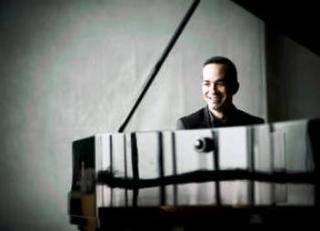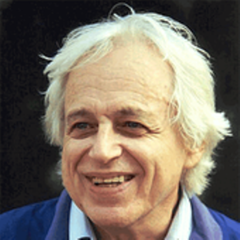|
Back
The Artist’s Imposing Quartet New York
92nd Street Y, Theresa L. Kaufmann Concert Hall
02/20/2016 -
Johannes Brahms/Johann Sebastian Bach: Piano Study for Left Hand, based on “Chaconne” from Violin Partita No. 2 in D minor, BWV 1004
Franz Schubert: Sonata in G Major, D. 894
György Ligeti: Musica Ricercata
Johannes Brahms: Variations and Fugue on a Theme by Handel, Opus 24
Inon Barnatan (Pianist)

I. Barnatan (© Courtesy of the Artist)
As proof of Inon Barnatan’s utmost seriousness, the Israeli-American pianist eschewed the usual recital which tacks from fireworks to finesse. His concert last night had its humor and its pyrotechnics, yes. Yet Mr. Barnatan presented four pieces, each formidable, each massive in purpose (if not length) and, in total, presenting an identifiable arch.
The two Brahms works which framed the recitals were not purely Brahms at all: they both showed Brahms’ veneration for Baroque music, with homages to Bach and Handel. In between was a unique performance of a very Classical Schubert sonata. And an extremely rare performance of György Ligeti’s complete Musica Ricerata, which also harked back to earlier periods.
But it was the least challenging work (at least to the audience), Schubert’s G Major Sonata, where Mr. Barnatan demonstrated why he has been praised for the composer. Rather than seeking out the dark mysteries, the sudden Sturm und Drang, the pianist played the piece as Schubert himself must have played it for his friends on the piano in his little room. With grace, lightness, with dance-like elegance.
The auditorium of the 92nd St. Y is too large to disguise the massive ff sounds of the score, but Mr. Barnatan managed to give the illusion of intimacy. Perhaps he was too strict in rhythms, perhaps he was too careful to make this four-movement jewel give out the right light. Equally, he saw this not as Schubert the Romantic, but Schubert delighting in Haydn and Mozart.
He was also careful in the opening Brahms arrangement of the Bach Chaconne. His right hand resting, his left hand played all the figurations down at the bottom of the keyboard with nary a mistake. On the other hand (no pun intended), by using his pedal so rarely, he made this imposing work very much a chamber piece.
(By the way, are any piano works written for the right hand? I think Scriabin did one, and Ned Rorem did a right-hand movement from a concerto. But can’t think of anyone else.)
For the second half, Mr. Barnatan avoided even the approximation of coy elegance. He went full-forward with two gigantic pieces, both played with his natural brilliance.

G. Ligeti (© Wikipedia)
And the first of these, all eleven sections of György Ligeti’s Musica Ricerata, gave a massive treatment to pieces which–according to the composer–are not supposed to be going anywhere!
The few pianists who play individual sections of Musica Ricerata destroy the cumulative meaning of the piece. Starting with a piece for one note (though cheating by going from the A to a final D), Ligeti continued with three notes...then four...going all the way to a complex fugue which he dedicated to the great contrapuntalist Girolamo Frescobaldi.
That was for technical scholars. The reality was that this was Ligeti at his most varied, inspired, eclectic form. The jazzy Allegro con spirito was never “serious music with a hint of syncopation”. It was the jazz of a man who appreciated every music. His piece in honor of Béla Bartók, was both memorial and dance-like imitation. That final fugue, while probably following Frescobaldi, cold have been the Bach Art of the Fugue pushed up a few centuries.
Mr. Barnatan had more than the notes to think about. Playing without a score, he pounded out the fff’s and the silent key depressions of the first piece. One wouldn’t have known it, but my score of the second movement has dynamic marks which are virtually impossible to play. A series of sffppps on the treble, with a simultaneous pp or crescendo down at the bottom.
A helluva task, but I have little doubt that this so careful pianist played it as literally as any pianist could. Two women in the audience staunchly walked out, and I was tempted to shout, like Charles Ives, “Stop being such a $#%^ sissy! Why can’t you use your ears like a man?”
The audience was terrifically receptive, giving way for the fourth imposing work, Brahms’s Handel Variations. Perhaps because they were never orchestrated by Brahms himself (though Edmund Rubbra did the task), they remain purely pianistic, and large and intense and with extraordinary inspiration, and they were played that way by Mr. Barnatan.
Nobody would think about putting out a recording of this concert, for his final fugue was blurred, a section where he surrendered his usual attention to give us the emotion of the moment. And that was fine, since this was an epic performance which no recording could ever catch.
In fact, after this recital, I prayed that Mr. Barnatan would not play an encore, so we could go back with the last notes of the Brahms ringing in our ears. Alas, he did a pastoral Bach anthem to the LGBT campaign for ovines, Sheep May Safely Be Gays. (I think that’s the title, but may have misheard.)
Encore forgiven, Mr. Barnatan offered a demanding structurally cohesive program. The kind of evening which can be honestly treasured.
Harry Rolnick
|